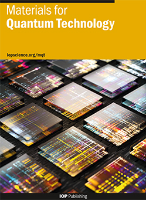
Materials for Quantum Technology
Scope & Guideline
Exploring Innovations in Quantum Technology
Introduction
Aims and Scopes
- Quantum Materials Engineering:
The journal publishes research on the engineering of materials specifically designed for quantum applications, including the synthesis and characterization of novel quantum materials such as quantum dots, nanocrystals, and defect centers in solids. - Integrated Quantum Photonics:
A significant focus is placed on the design and fabrication of integrated photonic devices that utilize quantum materials for applications such as single-photon sources, quantum memories, and quantum communication. - Quantum Sensing and Measurement:
Research that explores the principles of quantum sensing, including the use of materials for sensitive measurements and detection of quantum states, is a core area of the journal. - Theoretical and Computational Studies:
The journal also includes theoretical investigations and computational modeling that provide insights into the behavior of quantum materials and their potential applications in technology. - Characterization Techniques:
Papers often highlight innovative methods for characterizing quantum materials and devices, which are essential for validating theoretical predictions and improving material properties.
Trending and Emerging
- Hybrid Quantum Systems:
There is a notable increase in research on hybrid systems that combine various quantum materials, such as quantum dots with photonic waveguides, enhancing the capabilities of quantum devices. - Quantum Defects in Solids:
Studies are increasingly focusing on the properties and applications of quantum defects, particularly in materials like diamond and hexagonal boron nitride, for their potential in quantum sensing and information processing. - Advanced Characterization and Machine Learning:
Recent papers have begun integrating machine learning techniques to analyze and characterize quantum materials, highlighting a trend towards data-driven approaches in material science. - Quantum Communication Technologies:
Research on quantum communication, particularly involving on-demand single-photon sources and entangled photon pair generation, is emerging as a significant focus area, reflecting the need for secure communication protocols. - 2D Materials for Quantum Applications:
There is an increasing interest in two-dimensional materials, such as graphene and transition metal dichalcogenides, for their unique electronic and optical properties that can be harnessed for quantum technologies.
Declining or Waning
- Conventional Semiconductor Materials:
Earlier publications frequently emphasized traditional semiconductor materials like silicon and gallium arsenide. However, recent works suggest a shift towards more exotic materials and nanostructures, indicating a waning interest in conventional semiconductors. - Single Quantum Dot Technologies:
While single quantum dots were once a central theme, there appears to be a decline in research focused solely on these systems, as the community increasingly explores hybrid systems and integrated photonic devices. - Optomechanical Systems:
Research on optomechanical systems has seen a decrease in frequency, possibly due to the increasing complexity and focus on purely quantum systems rather than hybrid optomechanical approaches. - Basic Quantum Theory Applications:
Theoretical studies that apply basic quantum mechanics to material systems are becoming less common as the journal shifts towards more applied research that emphasizes practical implementations and technologies.
Similar Journals
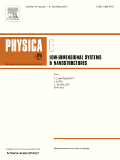
PHYSICA E-LOW-DIMENSIONAL SYSTEMS & NANOSTRUCTURES
Advancing the frontiers of nanoscience and condensed matter.PHYSICA E-LOW-DIMENSIONAL SYSTEMS & NANOSTRUCTURES, published by ELSEVIER, is a premier journal dedicated to advancing the field of condensed matter and nanoscience, focusing on the innovative properties and applications of low-dimensional systems. With an esteemed Q2 ranking in multiple categories including Atomic and Molecular Physics, Condensed Matter Physics, and Nanoscience for 2023, this journal serves as a vital platform for researchers and professionals aiming to disseminate and discuss cutting-edge research. Established in 1974 and converging its focus from 1997 onwards, PHYSICA E captures the evolving landscape of material science, making it a crucial resource for anyone invested in the dynamics of electronic, optical, and magnetic materials. Although the journal operates on a subscription basis, its broad accessibility and significant placement within Scopus rankings—such as being in the 83rd percentile for Condensed Matter Physics—underscore its importance within the academic community. Researchers and students alike will find this journal a cornerstone for fostering knowledge and collaboration in the fields of nanotechnology and low-dimensional physics.

EUROPEAN PHYSICAL JOURNAL B
Bridging Theory and Application in Condensed Matter ScienceEUROPEAN PHYSICAL JOURNAL B (ISSN: 1434-6028, E-ISSN: 1434-6036), published by Springer, is a prominent international journal based in Germany that focuses on the fields of Condensed Matter Physics and Electronic, Optical and Magnetic Materials. With a converged publication timeline from 1998 to 2024, it caters to a diverse audience that includes researchers, professionals, and students striving for the latest advancements in these vital areas of physics. The journal is recognized with a Q3 ranking in both relevant categories for 2023, showcasing its solid yet notable standing within the academic community. Although currently without an H-index, its Scopus rankings reflect a percentile performance of 41st and 39th, respectively, indicating a growing influence among its peers. The journal offers open access options, ensuring that groundbreaking research is widely accessible and contributes to the collective knowledge within the scientific domain. By aiming to publish high-quality, well-researched articles, the EUROPEAN PHYSICAL JOURNAL B plays a crucial role in disseminating innovative findings and fostering collaboration in the field of physics.
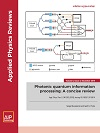
Applied Physics Reviews
Bridging Theory and Experiment in PhysicsApplied Physics Reviews, published by AIP Publishing, is a premier journal prominently positioned in the field of physics and astronomy. With an impressive impact factor that reflects its significance, this journal ranks in the 1st quartile (Q1) in 2023 and holds the 9th position out of 243 journals in General Physics and Astronomy according to Scopus, placing it in the 96th percentile of its category. Established as a vital platform for the dissemination of groundbreaking research and reviews, Applied Physics Reviews aims to bridge theoretical and experimental studies, enabling a comprehensive understanding of applied physics advancements. Although not open access, the journal provides a rich resource for researchers, professionals, and students keen on exploring the latest developments and trends within applied physics, offering insights that are crucial for both academic and industrial applications. With a converged timeline from 2014 to 2024, this journal continues to foster significant contributions to the field and encourages a collaborative dialogue among scholars and practitioners.
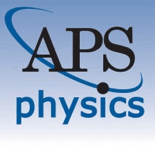
PHYSICAL REVIEW B
Elevating Knowledge in the Sciences of MaterialsPHYSICAL REVIEW B, published by the American Physical Society, is a leading journal in the field of condensed matter physics and materials science, particularly focusing on electronic, optical, and magnetic materials. With an ISSN of 2469-9950 and an E-ISSN of 2469-9969, this periodical has garnered a prestigious reputation, achieving a Q1 ranking in both relevant categories as of 2023. The journal has recorded significant impact as reflected in its Scopus ranks, notably positioned at #95 out of 434 in Condensed Matter Physics and #75 out of 284 in the Materials Science sector, illustrating its importance in advancing research and discussions in these critical areas. Although it does not offer open access, PHYSICAL REVIEW B remains an invaluable resource for academics, researchers, and professionals seeking to increase their understanding of contemporary issues in condensed matter and material sciences. Established in 2005, this journal continues to foster innovation and dissemination of knowledge, making it a cornerstone publication for those engaged in cutting-edge research.

Progress in Electromagnetics Research-PIER
Unveiling Innovations in ElectromagneticsProgress in Electromagnetics Research-PIER, published by EMW PUBLISHING, is an esteemed academic journal that stands at the forefront of the fields of Condensed Matter Physics, Electrical and Electronic Engineering, and Radiation. With an impressive impact factor reflected in its Q1 quartile rankings across these disciplines, PIER serves as a critical platform for disseminating high-quality research findings and advancements from 2000 onwards, with the latest contributions expected through 2024. The journal's commitment to excellence is evident as it holds prominent positions in Scopus rankings, including a remarkable 95th percentile in the field of Radiation. Researchers, professionals, and students will find PIER invaluable for accessing cutting-edge topics and methodologies that push the boundaries of electromagnetics research. For facile access, the journal is published in both ISSN (1070-4698) and E-ISSN (1559-8985) formats, ensuring that vital knowledge is readily available to its audience.
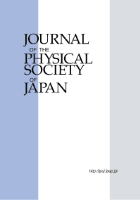
JOURNAL OF THE PHYSICAL SOCIETY OF JAPAN
Advancing the Frontiers of Physics and AstronomyThe JOURNAL OF THE PHYSICAL SOCIETY OF JAPAN, published by the Physical Society of Japan, has been at the forefront of advancing knowledge in the field of Physics and Astronomy since its inception in 1946. With a commendable reputation reflected in its Q2 ranking within its category for 2023, this journal serves as a vital platform for disseminating high-quality research and innovative concepts. Researchers and professionals alike can engage with cutting-edge studies and reviews that span a diverse range of topics pivotal to the physical sciences. Although the journal does not currently operate with an open access model, it maintains a robust impact on the global physics community, evidenced by its placement in the 59th percentile among a competitive pool of 243 journals. With an unwavering commitment to bridging theory and application, the JOURNAL OF THE PHYSICAL SOCIETY OF JAPAN continues to inspire and cultivate scholarly discourse and collaboration across disciplines.
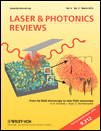
Laser & Photonics Reviews
Unveiling Breakthroughs in Condensed Matter PhysicsLaser & Photonics Reviews is a prestigious academic journal published by WILEY-V C H VERLAG GMBH, based in Germany. Since its inception in 2007, the journal has rapidly established itself as a leading outlet in the fields of Atomic and Molecular Physics, Condensed Matter Physics, and Electronic, Optical, and Magnetic Materials. With its impressive impact factor and presence in the Q1 category across multiple relevant disciplines, it ranks among the top-tier journals in its field—ranked #18 out of 434 in Condensed Matter Physics and #13 out of 224 in Atomic and Molecular Physics according to Scopus rankings. The journal emphasizes high-quality research that contributes significantly to theoretical and applied photonics, bridging gaps between fundamental science and practical applications. Although access is not open, it remains essential reading for researchers, professionals, and students eager to stay abreast of groundbreaking advances and applications in laser technology and photonics. For further information and to explore its compelling articles, please visit its official site.

Quantum
Empowering discoveries through open access to quantum knowledge.Quantum, an esteemed Open Access journal published by the Verein Förderung Open Access Publizierens Quantenwissenschaft, serves as a pivotal platform for the dissemination of groundbreaking research in the fields of atomic and molecular physics, and optics. Since its inception in 2017, Quantum has emerged as a leader in the academic community, boasting an impressive impact factor within the top quartile (Q1) in its categories, ranking #6 out of 81 in Physics and Astronomy (miscellaneous) and #35 out of 224 in Atomic and Molecular Physics, and Optics in 2023. With its global reach, based in Vienna, Austria, Quantum is dedicated to promoting innovative research and fostering collaboration among scientists, researchers, and students alike. The journal encourages unrestricted access to high-quality publications, ensuring that vital advancements in quantum science are available to all, thereby facilitating knowledge exchange and accelerating scientific progress. Explore the cutting-edge developments at the forefront of quantum studies and contribute to a vibrant scholarly community.

Physical Review Research
Fostering collaboration in cutting-edge scientific discovery.Physical Review Research, published by the American Physical Society, is a premier open access journal dedicated to the dissemination of high-quality research across all areas of physics and astronomy. Since its inception in 2019, this journal has quickly established itself as a vital platform for researchers, achieving a prestigious Q1 ranking in the dynamics of Physics and Astronomy (miscellaneous) and holding a commendable position in the Scopus Rankings with a rank of #29 out of 243, placing it in the 88th percentile. With the commitment to fostering scientific collaboration and transparency, Physical Review Research offers unrestricted access to valuable findings, enabling researchers, professionals, and students alike to engage with cutting-edge contributions in general physics and astronomy. As it converges into its forthcoming years of publication, the journal remains dedicated to showcasing rigorous research and innovative ideas that drive the field forward.

EPJ Quantum Technology
Advancing Quantum Frontiers with Open Access InsightsEPJ Quantum Technology is a prestigious open-access journal published by Springer, dedicated to advancing the fields of Quantum Technology, with a focus on areas such as atomic and molecular physics, condensed matter physics, and control engineering. Launched in 2014, this journal has quickly established itself as an influential platform for scholars and practitioners, achieving a remarkable Q1 ranking across multiple categories in 2023, indicative of its high impact and relevance in the scientific community. With an impressive Scopus ranking that places it in the top 15% for condensed matter physics and the top 20% for electrical and electronic engineering, EPJ Quantum Technology serves as a vital resource for researchers aiming to explore groundbreaking technologies and foster interdisciplinary collaboration. By providing unrestricted access to cutting-edge research, it plays a crucial role in disseminating knowledge that drives innovation and enhances understanding in this rapidly evolving field. Based in Germany and reaching an international audience, it is poised to impact the future of quantum science and technology significantly.